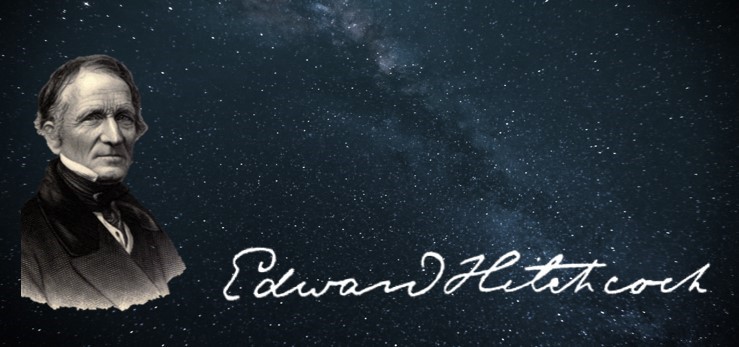
All the Light Here Comes from Above: Edward Hitchcock, Man of Science, Man of Faith
by Robert T. McMaster

Edward Hitchcock (1793-1864) was not the only star in the firmament of American science in the nineteenth century, but he was certainly one of the brightest. Raised among the wheat and rye fields of Deerfield, Massachusetts, he was expected to pursue a farmer’s life, but early in life he developed a “strong relish” for science. With little formal education, he went on to become one of the most eminent scientists of his time.
Hitchcock is best known for his pioneering work in paleontology, especially in deciphering the fossilized tracks of dinosaurs in the sandstone of the Connecticut Valley. But he was also one of the first American geologists to embrace such revolutionary ideas as Hutton’s views on the age of the Earth and Agassiz’s theory of continental glaciation. He published forty books on geology and authored more than 100 articles in the foremost scientific journals of his day. In 1840 he was elected the first chairman of the Association of American Geologists, a body that later came to be known as the American Association for the Advancement of Science, the nation’s preeminent scientific organization to this day. (1)
In addition to his scientific interests, Edward Hitchcock was also a deeply religious man, a Calvinist of the most orthodox stripe. He believed with all his heart in God, Jesus Christ, and the revelations of Holy Scripture. While he held a pastorate for only four years, he continued to preach throughout his four decades on the faculty at Amherst College. He published five books on religion (notably The Religion of Geology) and authored more than thirty articles in the religious press. (2)
In Hitchcock’s time, many people of faith were conflicted about new revelations of science. But not Edward Hitchcock. How could a believer in the biblical stories of the Creation, the Garden of Eden, and Noah’s Flood, also adopt a modern understanding of “deep time,” of continental glaciation, even of Darwinism? His theological solution to that conundrum is worthy of consideration even two centuries later: Edward Hitchcock believed that the hand of God guided his pursuit of scientific truth just as surely as it guided him in matters of morality and spirituality.
The Bible tells us that God created Heaven and Earth in six days. Hitchcock defended the biblical account of Creation, arguing that the Hebrew word “yom,” translated in the English of the King James Version as “day,” could be interpreted to mean almost any time interval. Thus the six “days” of creation could easily have meant a period of hundreds, millions, even billions of years, allowing ample time for geological processes to carry on, for sediments to be laid down, mountains built up, and organic remains converted to rock. This interpretation did not originate with Hitchcock. He heard it in lectures by Eleazar Fitch and Benjamin Silliman at Yale and read of it in the works of James Hutton and Robert Hooke. But Hitchcock promoted it forcefully and articulately in his writings for scientists and for theologians.
As to Noah’s Flood, geologists had unearthed evidence of many ancient deluges, any one of which might have been the subject of the biblical story. Much of that evidence had to do with the movement of rocks and boulders, some of immense size, that some geologists attributed to the Great Flood. In an 1823 sermon, Reverend Hitchcock made this argument to his parishioners regarding the “Noachian deluge”:
We have proof of it all around us in our everyday excursions. Whence came these numerous worn and rounded masses of stone which are scattered over the tops of our highest hills and mountains? Surely no river could have conveyed them thither. Nothing will account for their situation but an universal deluge. Let the unbeliever then remember that as he passes over our hills the very stones cry out against him. (3)
A few years later those very stones cried out loudly to Edward Hitchcock, but they told a dramatically different story. From 1830 to 1833, Hitchcock made a comprehensive geological survey of the state of Massachusetts, traveling nearly 3,500 miles in a horse-drawn wagon. In all regions of the state, he observed deep scratches and furrows inscribed in bedrock, all with northerly orientations. He found huge boulders scattered across the countryside, all carried dozens of miles in a southerly direction from their source. Traveling by steamer from Cape Cod to the islands of Nantucket and Martha’s Vineyard, he saw tree stumps exposed in shallow bays at very low tides. When Louis Agassiz published his landmark Études sur les Glaciers in 1840, Hitchcock was an immediate convert. In a speech delivered at the first meeting of the Association of American Geologists in Philadelphia in 1840, he described the experience with evangelical fervor:
While reading this work and the abstracts of some papers by Agassiz, Buckland and Lyell, on the evidence of ancient glaciers in Scotland and England, I seemed to be acquiring a new geological sense; and I look upon our smoothed and striated rocks, our accumulations of gravel, and the tout ensemble of diluvial phenomena, with new eyes. (4)
Was the biblical account of the Great Flood in error? Hitchcock argued that there had been many floods like the one in Genesis, but they were at best limited, regional events. And it was ice, not water, that was largely responsible for the present-day configuration of much of the Earth’s surface. The biblical account was not in error; it was simply limited by the experience of its writers. After all, he asserted, the Bible was never intended as a scientific document.
In many ways that speech marked the emergence of Edward Hitchcock as one of the most respected and influential scientists in America and in Europe. In the next few years, his research on the “fossil footmarks” gained ever-wider acceptance among geologists on both continents, men such as Henry D. Rogers, Ebenezer Emmons, William Buckland, and Charles Lyell. Charles Darwin praised Hitchcock’s 1841 Final Report on the Geology of Massachusetts as “a magnificent work.” (5) His acceptance of Agassiz’s glacial theory gave license to other scientists to adopt that revolutionary hypothesis: if a preacher of such impeccable Christian credentials could accept such notions, many believed, so could they.
One of Hitchcock’s articles of faith was that all life was created by God. However, the fossil record, he admitted, provided strong evidence that there was not just a single creation event, but rather a series of creations. He argued that God had initiated them to repopulate the Earth with lifeforms better suited to conditions on the planet.
Late in his life, Hitchcock confronted what was perhaps the greatest scientific challenge to his faith, the publication of Origin of Species. Charles Darwin argued that it was natural forces, not God, who created the diversity of life. Needless to say, Edward Hitchcock disagreed. In an article published in the journal Bibliotheca Sacra just months before his death, he first raised his concerns about Darwin’s formulations on religious grounds. In Hitchcock’s view they made unnecessary the existence of a Deity, they led to the “grossest materialism,” they rejected the concept of immortality, and they removed all moral responsibility of man to God.
After enumerating his religious objections to Darwinism, Hitchcock’s offensive pivoted in a new direction: “But after all, the real question is, not whether these hypotheses accord with our religious views, but whether they are true.” He then proceeded to state his scientific objections to Darwinism. First, if Darwin’s ideas were correct, he argued, there should be ample evidence of intermediate or transitional forms, yet there are none. Then he asked about man:
Whence came he? If he is only one of the lower animals metamorphosed, we ought surely to find a multitude of intermediate varieties. But not one has ever been brought to light…Man’s appearance at so late a period in the earth’s history, and so independent of all other species, seems a providential testimony to the absurdity of this hypothesis. (6)
As to the mechanism of transmutation, Darwin’s explanation did not convince Hitchcock. He believed that while natural selection might be capable of causing one species to give rise to another, only the Creator could set those processes in motion.
We might have expected Edward Hitchcock to leave the subject there, but he did not. In the end, he added this tantalizing thought on the idea of transmutation of species:
The fact that these new creations are repeated at intervals, and seem to form a part of a series of operations, which we know to be natural, makes it quite probable they also are natural. Perhaps this unknown law will by and by be discovered, as many new laws have been to explain phenomena once supposed to be miraculous because anomalous and inexplicable. (7)
Ever the empiricist, the venerable professor from Amherst could not rule out the possibility that species might in fact transmutate, or evolve, into new species. Had he lived long enough to see additional evidence for Darwin’s theories, the indefatigable Edward Hitchcock might well have found a way to accept them, to understand them as all a part of God’s plan.
In the century and a half since his death, Hitchcock’s reputation has had its ups and downs, particularly in regard to his hypothesis that fossil footmarks were made by ancient birds, some of them twelve to fifteen feet tall. Historian of Science, Dennis R. Dean in a 1969 article described Hitchcock as “…the last of the first-rate amateurs…the last significant geological theorist who dabbles, who creates, who imagines, and the grand assurances, the flights of pious imagination, which characterize his works are tragic in their obsolescence.” (8)
However, the tides began to turn in the late 1960s, as evolutionary biologists revised old notions of dinosaurs. Dinosaurs are now widely viewed as the direct ancestors of modern-day birds. It seems that Edward Hitchcock had it right all along. Robert T. Bakker, an eminent expert on dinosaurs, argues that the Amherst professor’s reputation deserves a makeover, that Hitchcock was the “…earliest and in many ways the best mind in dinosaur science.” (9)
Some historians have labelled Edward Hitchcock as one of the last of the Christian geologists (10). However, if by that term we mean one who allows religion to intrude upon and influence science, then I believe it is not a fair assessment of Edward Hitchcock. For he found his own way of bridging the gap between science and his faith. He believed that when properly understood and thoroughly investigated science would never lead him astray. He also believed that if he was diligent, thoughtful, and prayerful, one way or another, God would lead him to the truth. And one way or another, that truth would confirm his faith: “Scientific truth, rightly understood, is religious truth.” (11)
The most accurate assessment of Edward Hitchcock’s creed is not that he was conflicted about his faith and his science, but that he never let disagreements between those two realms discourage him from the search for truth. Far from being the last of the Christian geologists, he may have been one of the first of a new breed of scientist, men and women possessed of a strong religious principle while remaining true to science.
The story is told, although the source is unknown, of an incident late in the teaching career of Edward Hitchcock. His senior geology class was meeting for the first time in a newly renovated lecture room on the upper floor of a campus building, a room that had been equipped with a window in the roof to better illuminate the space beneath. Such a window may have been unusual in his day, a modern architectural innovation. The old professor stood before his class gazing up at the new window and smiling as he spoke the words that might be regarded as the guiding principle of his life: (12)
“Young gentlemen, all the light we have here comes from above.”

Robert T. McMaster taught biology at Holyoke Community College in Holyoke, Massachusetts, for twenty years until his retirement in 2014. He has recently published the first biography every written of Edward Hitchcock, All the Light Here Comes from Above: The Life and Legacy of Edward Hitchcock. For see information see his Researcher Profile.
References
(1) Robert T. McMaster, All the Light Here Comes from Above: The Life and Legacy of Edward Hitchcock (Williamsburg, Mass., Unquomonk Press, 2021).
(2) Click here for a complete bibliography of the works of Edward Hitchcock.
(3) Edward Hitchcock. “Noachian Deluge,” Sermon Number 128, January 1823, Edward and Orra White Hitchcock Papers, Amherst College Archives and Special Collections, Amherst, Massachusetts, Series 3, Sub-series A, Box 7: folder 7. See also Robert T. McMaster, “Lord Is It I? The Sermons of Edward Hitchcock,” Historical Journal of Massachusetts 48 (Summer, 2020): 112.
(4) Edward Hitchcock, “First Anniversary Address Before the Association of American Geologists,” American Journal of Science and Arts 41 (1841): 232-275.
(5) Robert T. McMaster, ““Edward Hitchcock’s Geological Survey of Massachusetts: 1830-1833,” Earth Sciences History 39(1) (2020): 91-119.
(6) Edward Hitchcock, “The Law of Nature’s Constancy Subordinate to the Higher Law of Change,” Bibliotheca Sacra and Biblical Repository 20 (July 1863): 524-5.
(7) Edward Hitchcock, “The Law of Nature’s Constancy Subordinate to the Higher Law of Change,” 547-8.
(8) Dennis R. Dean, “Hitchcock’s Dinosaur Tracks,” American Quarterly 21 (Autumn 1969): 644.
(9) Robert T. Bakker, “Introduction: Dinosaurs Acting Like Birds, and Vice Versa–An Homage to the Reverend Edward Hitchcock,” In Feathered Dragons: Studies on the Transition from Dinosaurs to Birds, edited by Philip J. Currie, Eva B. Koppelhus, Martin A. Shugar, and Joanna L. Wright (Bloomington, IN: Indiana University Press, 2004), 1-11.
(10) Philip J. Lawrence, “Edward Hitchcock: The Christian Geologist,” Proceedings of the American Philosophical Society 116 (February 1972): 21-34.
(11) Edward Hitchcock, The Religion of Geology and Its Connected Sciences (Boston, Mass.: Phillips, Sampson, and Company, 1851), 476.
(12) The anecdote, probably from one of Hitchcock’s students, was reported in many newspapers and periodicals. For example, The Intelligencer (Anderson, SC), June 2, 1897, 4; Current Anecdotes, October 1903, 14; Church School Journal, January 1911, 37.
